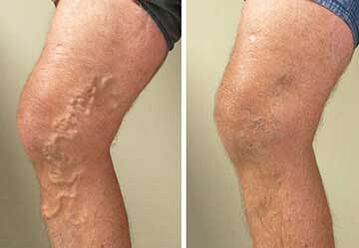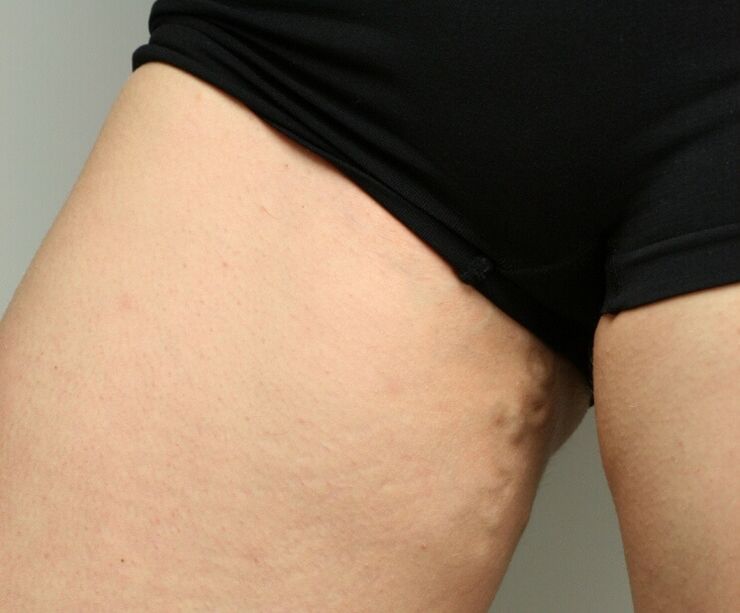In the human body, a network of blood vessels is provided in order to provide any part of the body with oxygen and the necessary nutrients for the proper course of the metabolic processes: arteries and veins. Oxygen -saturated blood flows through the arteries, and blood with processing products flows through the veins: carbon dioxide and waste from metabolic processes that must be carried to the organs to remove them from the body. But if the blood rate is quite high along the arteries, then the blood flow slows into the veins and the blood contained in them, overcomes the power of gravitational attraction, returning to the heart. So there is no mechanical blood flow to the veins, valves are provided that open only in one direction up. After closing them, the blood cannot flow down. But for a number of reasons, these valves lose their elasticity, elasticity and do not close, allowing some of the blood in the veins to lower and accumulate in the veins in greater volume than provided that with physiological laws.
This excess volume of blood causes the widening of the veins and causes a change in the wall of the blood vessels - pockets are formed where stagnant blood is collected. This whole pathological process is called varicose disease or varicose veins. More often, varicose veins are manifested in the legs, as a larger volume of venous blood is collected here, but it is not uncommon in the hands. What contributes to this? Reasons for varicose veins
There must be predisposing factors for the development of any disease and provoke. The first includes:The hereditary of the transmission of instability of the structure of the circulatory system, more specially the apparatus of the valve,congenital changes in vessels,Disorders of the metabolic processes, which leads to thinning of the wall of the vessel and the loss of elasticity (diabetes mellitus, impaired thyroid and adrenal function),Age changes in the walls of the vessels.
Provoking factors:A sedentary lifestyle, there is no need for muscle work to shrink and mechanically pass the blood through the vessels,Long -term standing of your feet during the day (teachers, hairdressers, behind the machine in factories, etc. ),Excess body weight,Pregnancy (metabolism changes and the load on the legs increases and intravascular pressure increases during birth), Long and frequent exercise with weight lifting (bars, hamal),injuries to the muscles of the limbs or blood vessels,The toxic effect of nicotine, alcohol, chemicals, medicines.Clinical manifestations of varicose veins of the arms and legsIt all starts with complaints of fatigue in the legs or arms, their rapid fatigue, a feeling of heaviness and numbness in them first appears at the beginning until the end of the working day, and then constantly.Swelling occurs, swelling, more often observed on the legs in the evening.The extended vessels become noticeable, first with physical activity and stress, and then they are seen at rest, the so -called vascular stars.Confusion (cones) occurs along the vessel, increasing volume during exercise or with coughing, sneezing (with an increase in intra -abdominal pressure). Varicose veins of pelvic veins
Varicose veins of pelvic veins
It is characterized by long -term pelvic pain, abundant disposal from the vagina, painful sexual acts, rapid urination and urinary incontinence. Regree and childbirth, tumors in the pelvis and uterus are a provocative factor that mechanically squeezes the veins, increases in the aba. The pain can be applied to any part of the abdomen, but more often in the groin and sacrum. Expanding the veins of the inside -abdominal space
The most dangerous enlargement of the liver veins (portal veins) and the esophagus. They expand more often, but are dangerous to health through possible bleeding from them, which means the difficulty in providing medical attention in this case.Dangerous complications of varicose diseaseVenous blood stagnates in the veins and does not undergo cleaning of harmful substances and toxins over time, which means that the body is constantly subjected to self -reflection, which further exacerbates metabolic disorders and intoxication.In the nodes or pockets of the blood vessels, the volume of the blood accumulates, the blood cells (platelets) are glued together and a thrombus is formed. It can close the lumen of the same vessel and can reach the vessels of the lungs, the heart, the brain with a blood flow and cause a disorder of the blood supply that manifests itself: Acute pulmonary artery thromboembolism (violation of respiratory that leads to the death of the patient),A stroke that may have a different nature of function impairment (from mild limb paresis to deep damage and even fatal result),myocardial infarction and light,Blood vessel thrombosis, leading to blindness.Stages of varicose veins
The first is the stage of complaints when there are no visible signs of vascular damage:Convulsive tightening of the muscles of the posterior surface of the legs, brushes and shoulder;night burning pain in them;Swelling of the legs and arms after exercise and if you specially lower your arm or legs down and hold a long time without movement, the shoes comfortable in the evening begin to cause discomfort in the legs.
The second -the pain becomes more resistant in intensity, the longer "vascular stars" appears, swelling of the legs that may not pass during sleep until morning. There are restrictions on work, the need for a short -term rest.
The third - the pain and the tingling intensify, become a permanent character, at night, during sleep it is difficult for a person to find a comfortable position. Expressed visual changes from the skin appear - the dry skin intensifies, the tendency to crack, the veins are noticeably expanding, nodes appear. The night break does not give relief to well -being. For long ridiculous ulcers appear quickly, in the late period the inflammation in them joins - thrombophlebitis. Diagnosis of vein enlargementCorrectly evaluate the patient's complaints.An ultrasound examination will be noticed through the abdominal wall or through the vagina for pelvic pain - the presence of batch turns and the expansion of the lumen.Dopplerography allows you to evaluate the rate of blood flow through the veins.
In severe and not quite understandable cases, surgeons resort to laparoscopy. Varicose veins
Varicose veins
Not treating drugs - to normalize the right lifestyle to maintain body weight for age, to rest your work and to be able to walk, not to limit fluid intake. During the rest, give your feet a raised position. Use compression linen if necessary (socks, golf). Massage courses, exercise, spa treatment.
Drug treatment - taking special medicines in tablets or use local locations in the form of applications and compresses
Surgical treatment - aimed at removing the damaged vein or its plastic.How to prevent the development of varicose veinsPeople who are at risk (drivers, hairdressers, seamstresses, surgeons, heavy workers) should carefully listen to changes in the body while noticing and evaluating pain syndrome and does not write off all about general fatigue.Try to turn off the long -term forced positions of the body - sit with an abandoned leg on another knee, sit "squatting". Change the position of the body more often.During the day, to perform a small warm -up (walk, tilting the body forward and forth, squat), so this will allow the muscles of the limbs to pump mechanically blood vessels. Run a little or jump in place.Follow and make weight adjustment, especially in adulthood, when the blood flow rate tends to decrease.Do not wear things that tighten the body, exclude delay in linen.Change the height of the heel during the day from high to low. Preference to give a height of 2-5, 5 cm.Be sure to walk barefoot in artificial gravel (carpets with needles, imitation shells).A healthy diet high in vitamin C (green, sauerkraut, berries).Turn off bad habits.Massage courses or lymphatic drainage sessions.Participate in swimming if there are no contraindications (disc herniation) - Scandinavian walking.
Caution: Different veins are progressive, it is not susceptible to complete treatment and is quite dangerous with your complications. You should always remember this and take measures to prevent from a young age and not neglect them when there are subsequently. Foot health care is a care of a healthy old age.





















